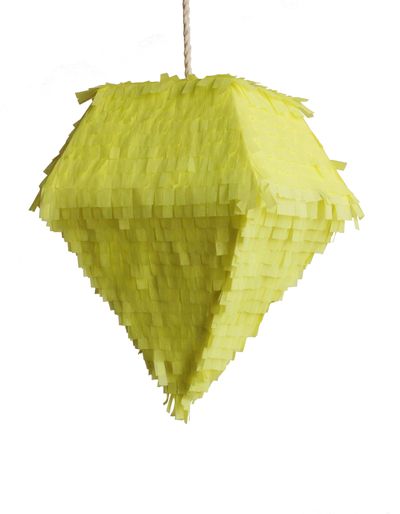Pinatas add festive touch to parties

With the school year underway and a new season of birthdays, class parties and holiday gatherings, now’s a good time to make a few eye-catching pinatas.
Unlike store-bought pinatas, which are generally made of cardboard and can be difficult to break, papier-mache pinatas are the real thing.
And homemade ones aren’t reserved for children’s birthday parties. Modern pinatas can be sleek and geometrical for grown-up gatherings, adding pizazz to holidays like Halloween (pumpkins, ghosts and spiders), Hanukkah (dreidels), Christmas (trees, reindeer or Santa) and New Year’s (stars). They can even be part of weddings (hearts, of course).
And you can fill them with goodies far more creative than the candies usually found in store-bought pinatas. How about black and orange confetti and plastic snakes and spiders for Halloween? Tiny plastic kazoos and noise-makers for New Year’s?
Making a pinata can take just a half hour a day over a few days or evenings. And it’s easy. All you need is some inspiration, a form around which to wrap a few layers of flour and water-soaked newsprint, some string, glue, and crepe paper or paint.
The first step is to create the form around which you’ll wrap the papier-mache, which starts out wet and soft and dries one layer at a time to form a hard shell.
The standard method is to use a balloon, then add cardboard tubing from toilet paper or paper towel rolls to form the desired shape. More geometrical forms can be made using wire or a frame cut from cardboard.
Although there are numerous variations, the classic papier-mache recipe is about 2 parts water to 1 part flour, blended until it forms a smooth, watery paste. A mix of water and glue can also be used.
Strips of torn newsprint or magazine pages (rough edges stick better than neatly cut edges) are dipped in the papier-mache mixture until they are soaked but not dripping, and then are stuck one by one onto the frame or balloon until the shape is completely covered, leaving a small hole where goodies can be inserted later.
Once the paper layer is completely dry – each layer can take a day to dry indoors, sometimes less if left in the sun – it’s time for another layer, and time to pop the balloon inside. It’s important that each layer dry completely, otherwise the papier-mache can become moldy. At least three layers of papier-mache are generally needed for a pinata. If colored paper is used for the final layer (like black for a bat or orange for a pumpkin), no painting or tissue paper covering is even needed.
Next comes the decorating. Get creative: You can cover the pinata with layers of glued-on crepe or tissue paper, strips of shiny or sparkly paper, paper cupcake liners or colored Post-Its – or a simple layer of paint. Eyes and other accessories are available at craft stores.
Attach a string to hang the pinata by punching two small holes at the top and threading it through. Fill the pinata with small and relatively lightweight goodies of any kind.
For a Halloween bat, for instance, Martha Stewart Living suggests using one large and one small balloon as forms for the papier-mache pinata, with the final layer of paper on each balloon done in black crepe paper. The big balloon is then filled with goodies and the two sections are attached, with the larger sphere becoming the bat’s body and the smaller sphere the head. Cut large, black, wing-shaped pieces out of posterboard and attach them with black duct tape. Make a scary face by drawing or using cutouts.
A jack-o-lantern pinata is even easier, consisting of one large balloon with a toilet paper roll for the stem, if desired. It can be decorated with orange paper and an appropriately scary face, filled through a hole at the top, and hung using a piece of string attached to either side of the “stem.”